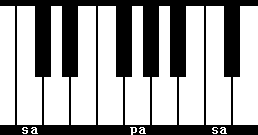Enter Melam number(1 to 72) >
OR
and click OK.


To know what notes are used in a 'Janya' Raagam, we have to know the type of notes used in the 'Janaka' Raagam. If the logic behind the 72 Melam system is known the notes used can be found from the melam number which is usually mentioned in the books containing notations. Click here to find notes (illustrated on a keyboard and with official names) from melam number.You can get simple audio without gamakam. If your connection is slow use Firefox(v 31+) or Chrome(v 31+).
You will find that the white note next to sa is sometimes ri2 (melam 29) and sometimes ga1 (melam 1) However, some books with notation also give the note names with subscripts - ri1,ri2,ri3 - three different names for ri, ga, da and ni. With 16 names still we have only 12 positions and this will be clear when we got into the Melam system in detail. In the earlier books published with notation in English ri1 corresponds to the black note after sa and ri2 to the next white note and so on. In the case of ma, ma1 will be white and ma2 black. In some more recent books and notation published in the web, while for ri and da there is no change, for ga, ga2 will be the black note next to ri2 and ga3 the white note next to it; ga1 here will be the same white note as ri2. Similar approach is made for ni. To find out which system is used check melam 29. If the ga is ga3 then it is the later system. Similarly for melam 22 if the ga is ga2 it is the later system. Others may give the official names like Suddha Rishabham or Chathusruthi Dhaivatham, which are unambiguous and can be understood when we see how the 72 melams are defined.
The Janaka or Melkartha is often mentioned in books of notation for each composition. Often only the melam number is mentioned. Description of the Raagam in theory books or to charts providing list of Janyas for each Janaka can also help. Such lists are available on the Internet (for instance this Wikipedia page gives both parent melam number and notes in ri1,ri2,ri3 fashion).